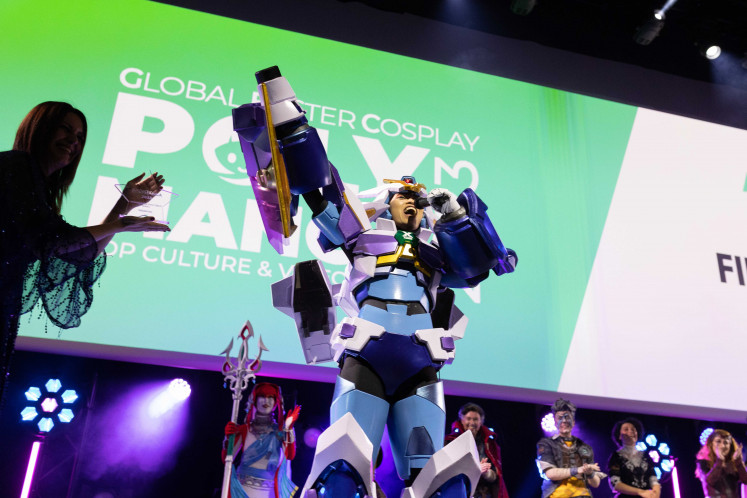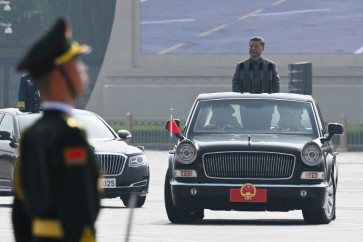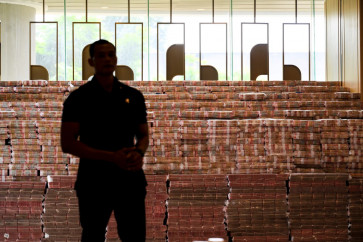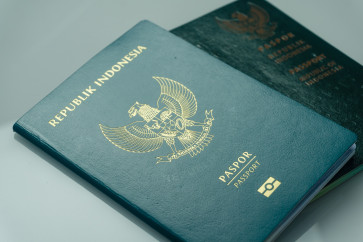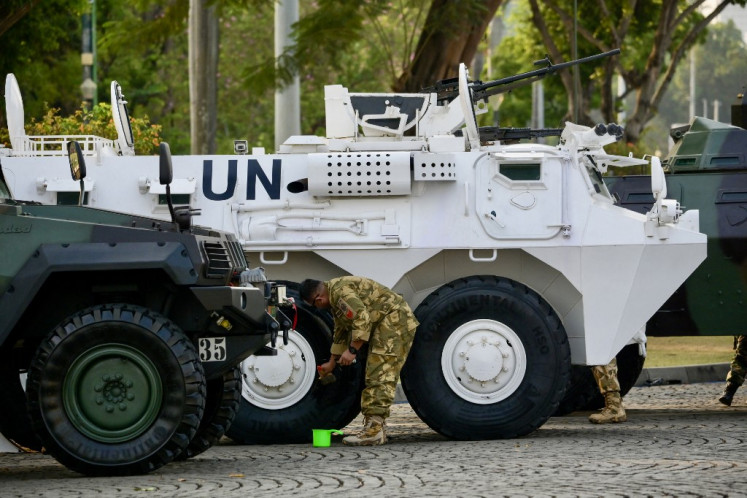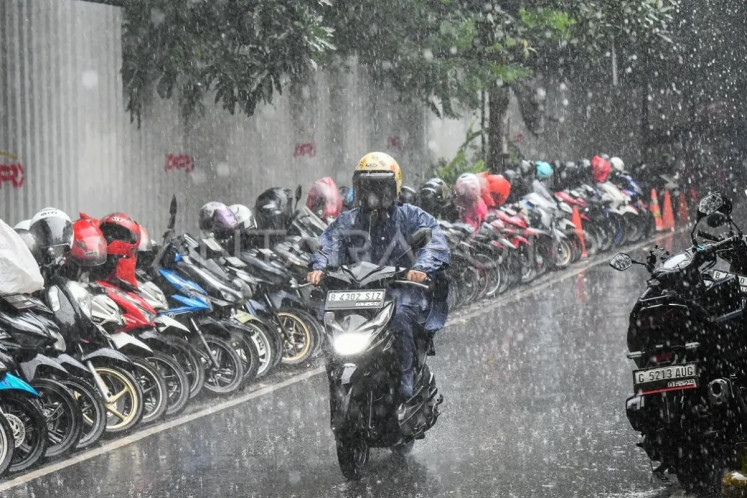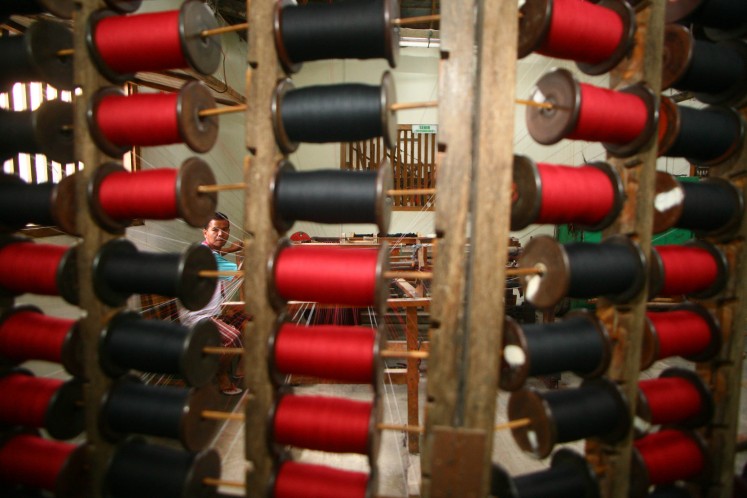Popular Reads
Top Results
Can't find what you're looking for?
View all search resultsPopular Reads
Top Results
Can't find what you're looking for?
View all search resultsPolitics, Indonesia & the art of the meme
The cartoon transforms the presidential contenders into Javanese pop singers Prabawati (who will âbeat your heart with loveâ, according to the text) and Jokowati (whose smile is like a blusukan, or impromptu visit, to your heart)
Change text size
Gift Premium Articles
to Anyone
![The cartoon transforms the presidential contenders into Javanese pop singers Prabawati (who will âbeat your heart with loveâ, according to the text) and Jokowati (whose smile is like a blusukan, or impromptu visit, to your heart). " border="0" height="462" width="599"><span class="caption" style="width: 597px;">The cartoon transforms the presidential contenders into Javanese pop singers Prabawati (who will âbeat your heart with loveâ, according to the text) and Jokowati (whose smile is like a blusukan, or impromptu visit, to your heart). </span></span></p><p>Amid the flourishing harsh and deceitful political pictorials around the social media sphere, Indonesian netizens turn to wit and humor for relief.</p><p>Noted blogger and social media activist Enda Nasution observed that the quickest pictorials to surface and the fastest to be shared were those which were smart and funny.<br><br>âThose with a generous amount of humor and an inspirational message are the fastest to go viral. Thereâs no lack of ill-intentioned pictorials, but those with positive sentiments always trump the negative ones,â Enda says.<br><br>Social media pundit Pangeran Siahaan also observed that pictorials with puns were the most popular with Indonesian netizens.<br><br>âI think because Indonesians love puns, most of the pictorials were made around wordplay. They are also easily understood and generate chuckles,â Pangeran said.<br><br>Among the most popular political pictorial producers is Rendy Imandita, who displays his work through his Twitter account @imandita.</p><p><span class="inline inline-none"><img class="image image-_original " src="http://202.158.21.182/files/images2/sp03-tsackrace.jpg" alt="sack race: Photoshop montages of Prabowo Subianto and Joko âJokowiâ Widodo in a sack race in front of the State Palace, as other politicians, such as Aburizal Bakrie and Surya Paloh lag behind." title="sack race: Photoshop montages of Prabowo Subianto and Joko âJokowiâ Widodo in a sack race in front of the State Palace, as other politicians, such as Aburizal Bakrie and Surya Paloh lag behind." border="0" height="449" width="413"><span class="caption" style="width: 411px;">Photoshop montages of Prabowo Subianto and Joko âJokowiâ Widodo in a sack race in front of the State Palace, as other politicians, such as Aburizal Bakrie and Surya Paloh lag behind.</span></span><br>âI make them because I like making them,â said Rendy, who has more than 15,000 followers on his account, adding that he was not part of either presidential campaign team nor was he commissioned by one.<br><br>Rendy said that although the objective of a meme was fun and to create smiles, he needed to be aware of certain issues around the presidential campaign.<br><br>âI have to know what topics or issues are currently being talked about. I focused on making images that campaigned for the success of the election, not to hate one of the candidates,â said Rendy, who works as an art director for an advertising company.<br><br>Rendy said information, when presented in visual and Internet meme form, was more attractive and encouraged sharing. <br><br>âI think the presidential election has been more lively and creative thanks to these creative memes,â he says.<br><br>Another popular pictorial personality is Agan Harahap, who uploads high quality manipulated photographs, juxtaposing presidential candidates with international celebrities.<br><br>Agan said the political photo manipulation was his response to the euphoria surrounding the presidential election.<br><br>âI had previously produced photo manipulations of myself with national figures as part of works of art. When the discussion and conversation about the election intensified, I was attracted to join in,â said the Yogyakarta-based photographer and artist.</p><p><span class="inline inline-none"><img class="image image-img_assist_custom-593x174 " src="http://202.158.21.182/files/images2/sp03-macan.img_assist_custom-593x174.jpg" alt="Dueling candidates: âHey,â proclaims Prabowo Subianto in the meme to the left. âIâm an Asian Tiger! Want me to strike?â Jokowiâs meme says, âIâm a calon presiden [official presidential candidate] for Indonesia. When are you going to become a calon suami?â The phrase, which literally means candidate husband, translates as becoming engaged. (Various sources)" title="Dueling candidates: âHey,â proclaims Prabowo Subianto in the meme to the left. âIâm an Asian Tiger! Want me to strike?â Jokowiâs meme says, âIâm a calon presiden [official presidential candidate] for Indonesia. When are you going to become a calon suami?â The phrase, which literally means candidate husband, translates as becoming engaged. (Various sources)" border="0" height="172" width="593"><span class="caption" style="width: 591px;"><strong>Dueling candidates: </strong>âHey,â proclaims Prabowo Subianto in the meme to the left. âIâm an Asian Tiger! Want me to strike?â Jokowiâs meme says, âIâm a calon presiden [official presidential candidate] for Indonesia. When are you going to become a calon suami?â The phrase, which literally means candidate husband, translates as becoming engaged. (Various sources)</span></span><br>As his work went viral, Agan received many reactions from people in social media circles. âIt was pretty divided reaction. Those who liked my work, loved it; those who didnât, had very unpleasant words,â he said.<br><br>Agan said he did not intend his artwork to be a political meme. <br><br>âI had no intention of getting into the political situation. I made them purely for fun. Besides, they were not actually memes,â he said.<br><br>Pangeran said very few of the political pictorials that color the social media landscape were Internet memes.<br><br>âIn its technical definition a meme has to be viral, spontaneously shared and easily personalized. Flexibility is a key element in a meme, because it allows people to modify the image. A meme is technically a template, which is why almost every meme â like the ones you find on 9gag.com â is related to certain themes,â Pangeran said.<br><br>âAn image can have photographs and text and be virally shared, but itâs not always necessarily a meme.â <br><br>According to Enda, election-related pictorials shared in the recent months fell into three basic categories.<br><br>âThe first category, unfortunately, were those which aimed to attack one candidate while supporting the other. Many took the form of negative campaigning and even smears,â Enda said.<br><br>The second type of pictorials, he continued, were the exact opposite by being lighthearted, humorous and putting forward the positive side of candidates.</p><p><span class="inline inline-none"><img class="image image-img_assist_custom-600x476 " src="http://202.158.21.182/files/images2/sp03-lcat.img_assist_custom-600x476.jpg" alt="âOMG!!!â proclaims the cat âI forgot that the presidential election was tomorrow.â" title="âOMG!!!â proclaims the cat âI forgot that the presidential election was tomorrow.â" border="0" height="476" width="599"><span class="caption" style="width: 597px;">âOMG!!!â proclaims the cat âI forgot that the presidential election was tomorrow.â</span></span><br>âA third category was inspiring and interactive. One example of this was a template with which people could combine their pictures and set up as their account pictures or avatars,â Enda said.<br><br>The 2014 election was expected to be influenced by digital activism, which is currently on the rise in Indonesia and mainly initiated by young people.<br><br>According to research organization Pamflet, which focuses on issues among young people, Indonesianâs between 17 and 30 years old represent around 60 percent of social media users today, with 13 percent of them having been engaged in the digital world for the past five years.<br><br>As digital civic activism is currently centralized among the youth, the combination of digital platforms and youth has become an essential element in looking at the future of democracy in Indonesia.<br><br>Rendy said besides providing humor during the election, political memes also played a role in campaigning for successful and peaceful voting.<br><br>âVisual imaging is easier to understand and more attractive, making a meme a useful way to reach people who are uninformed about the election or even swing voters,â he said.<br><br>Enda said for those who had made up their mind about whom to vote for, political memes would not have much effect.<br><br>âSwing voters, however, are a main target of political memes generated by presidential campaign teams. Each campaign team looked to use memes to garner social approval.â</p><p><span class="inline inline-none"><img class="image image-img_assist_custom-598x522 " src="http://202.158.21.182/files/images2/sp03-aganteng.img_assist_custom-598x522.jpg" alt="The two candidates standing in front of Indonesian flags with text proclaiming them both ganteng, or handsome. âSo choose whoeverâs handsome,â the meme concludes. âNo need for fighting.â " title="The two candidates standing in front of Indonesian flags with text proclaiming them both ganteng, or handsome. âSo choose whoeverâs handsome,â the meme concludes. âNo need for fighting.â " border="0" height="520" width="598"><span class="caption" style="width: 596px;">The two candidates standing in front of Indonesian flags with text proclaiming them both ganteng, or handsome. âSo choose whoeverâs handsome,â the meme concludes. âNo need for fighting.â </span></span></p><p><span class="inline inline-none"><img class="image image-img_assist_custom-600x432 " src="http://202.158.21.182/files/images2/sp03-btwocandidates.img_assist_custom-600x432.jpg" alt="The cartoon shows the candidates taking a selfie while embracing warmly. Canât we all get along?" title="The cartoon shows the candidates taking a selfie while embracing warmly. Canât we all get along?" border="0" height="432" width="599"><span class="caption" style="width: 597px;">The cartoon shows the candidates taking a selfie while embracing warmly. Canât we all get along?</span></span></p><p><span class="inline inline-none"><img class="image image-img_assist_custom-600x380 " src="http://202.158.21.182/files/images2/sp03-kChubby-kid.img_assist_custom-600x380.jpg" alt="Chubby kid: This meme, locally known as anak gendut, or âchubby kidâ, features the hapless child making a phone call. âHey, Mr. policeman. If youâve got some angry [presidential] supporters, send them to me,â the meme says. âIâll swallow them.â (Meme Generator)" title="Chubby kid: This meme, locally known as anak gendut, or âchubby kidâ, features the hapless child making a phone call. âHey, Mr. policeman. If youâve got some angry [presidential] supporters, send them to me,â the meme says. âIâll swallow them.â (Meme Generator)" border="0" height="380" width="598"><span class="caption" style="width: 596px;"><strong>Chubby kid: </strong>This meme, locally known as anak gendut, or âchubby kidâ, features the hapless child making a phone call. âHey, Mr. policeman. If youâve got some angry [presidential] supporters, send them to me,â the meme says. âIâll swallow them.â (Meme Generator)</span></span></p><p><span class="inline inline-none"><img class="image image-img_assist_custom-596x338 " src="http://202.158.21.182/files/images2/sp03-msby.img_assist_custom-596x338.jpg" alt="The meme depicts outgoing President Susilo Bambang Yudhoyono â perhaps appealing to voters tired of the election â saying, âIâm still handsome, right?â (Various sources)" title="The meme depicts outgoing President Susilo Bambang Yudhoyono â perhaps appealing to voters tired of the election â saying, âIâm still handsome, right?â (Various sources)](https://www.thejakartapost.com/files/images2/sp03-dprabawati.img_assist_custom-599x463.jpg) The cartoon transforms the presidential contenders into Javanese pop singers Prabawati (who will âbeat your heart with loveâ, according to the text) and Jokowati (whose smile is like a blusukan, or impromptu visit, to your heart). " border="0" height="462" width="599">The cartoon transforms the presidential contenders into Javanese pop singers Prabawati (who will âbeat your heart with loveâ, according to the text) and Jokowati (whose smile is like a blusukan, or impromptu visit, to your heart).
The cartoon transforms the presidential contenders into Javanese pop singers Prabawati (who will âbeat your heart with loveâ, according to the text) and Jokowati (whose smile is like a blusukan, or impromptu visit, to your heart). " border="0" height="462" width="599">The cartoon transforms the presidential contenders into Javanese pop singers Prabawati (who will âbeat your heart with loveâ, according to the text) and Jokowati (whose smile is like a blusukan, or impromptu visit, to your heart). Amid the flourishing harsh and deceitful political pictorials around the social media sphere, Indonesian netizens turn to wit and humor for relief.
Noted blogger and social media activist Enda Nasution observed that the quickest pictorials to surface and the fastest to be shared were those which were smart and funny.
âThose with a generous amount of humor and an inspirational message are the fastest to go viral. Thereâs no lack of ill-intentioned pictorials, but those with positive sentiments always trump the negative ones,â Enda says.
Social media pundit Pangeran Siahaan also observed that pictorials with puns were the most popular with Indonesian netizens.
âI think because Indonesians love puns, most of the pictorials were made around wordplay. They are also easily understood and generate chuckles,â Pangeran said.
Among the most popular political pictorial producers is Rendy Imandita, who displays his work through his Twitter account @imandita.
 Photoshop montages of Prabowo Subianto and Joko âJokowiâ Widodo in a sack race in front of the State Palace, as other politicians, such as Aburizal Bakrie and Surya Paloh lag behind.
Photoshop montages of Prabowo Subianto and Joko âJokowiâ Widodo in a sack race in front of the State Palace, as other politicians, such as Aburizal Bakrie and Surya Paloh lag behind.
âI make them because I like making them,â said Rendy, who has more than 15,000 followers on his account, adding that he was not part of either presidential campaign team nor was he commissioned by one.
Rendy said that although the objective of a meme was fun and to create smiles, he needed to be aware of certain issues around the presidential campaign.
âI have to know what topics or issues are currently being talked about. I focused on making images that campaigned for the success of the election, not to hate one of the candidates,â said Rendy, who works as an art director for an advertising company.
Rendy said information, when presented in visual and Internet meme form, was more attractive and encouraged sharing.
âI think the presidential election has been more lively and creative thanks to these creative memes,â he says.
Another popular pictorial personality is Agan Harahap, who uploads high quality manipulated photographs, juxtaposing presidential candidates with international celebrities.
Agan said the political photo manipulation was his response to the euphoria surrounding the presidential election.
âI had previously produced photo manipulations of myself with national figures as part of works of art. When the discussion and conversation about the election intensified, I was attracted to join in,â said the Yogyakarta-based photographer and artist.
![Dueling candidates: âHey,â proclaims Prabowo Subianto in the meme to the left. âIâm an Asian Tiger! Want me to strike?â Jokowiâs meme says, âIâm a calon presiden [official presidential candidate] for Indonesia. When are you going to become a calon suami?â The phrase, which literally means candidate husband, translates as becoming engaged. (Various sources) Dueling candidates: âHey,â proclaims Prabowo Subianto in the meme to the left. âIâm an Asian Tiger! Want me to strike?â Jokowiâs meme says, âIâm a calon presiden [official presidential candidate] for Indonesia. When are you going to become a calon suami?â The phrase, which literally means candidate husband, translates as becoming engaged. (Various sources)](http://202.158.21.182/files/images2/sp03-macan.img_assist_custom-593x174.jpg) Dueling candidates: âHey,â proclaims Prabowo Subianto in the meme to the left. âIâm an Asian Tiger! Want me to strike?â Jokowiâs meme says, âIâm a calon presiden [official presidential candidate] for Indonesia. When are you going to become a calon suami?â The phrase, which literally means candidate husband, translates as becoming engaged. (Various sources)
Dueling candidates: âHey,â proclaims Prabowo Subianto in the meme to the left. âIâm an Asian Tiger! Want me to strike?â Jokowiâs meme says, âIâm a calon presiden [official presidential candidate] for Indonesia. When are you going to become a calon suami?â The phrase, which literally means candidate husband, translates as becoming engaged. (Various sources)
As his work went viral, Agan received many reactions from people in social media circles. âIt was pretty divided reaction. Those who liked my work, loved it; those who didnât, had very unpleasant words,â he said.
Agan said he did not intend his artwork to be a political meme.
âI had no intention of getting into the political situation. I made them purely for fun. Besides, they were not actually memes,â he said.
Pangeran said very few of the political pictorials that color the social media landscape were Internet memes.
âIn its technical definition a meme has to be viral, spontaneously shared and easily personalized. Flexibility is a key element in a meme, because it allows people to modify the image. A meme is technically a template, which is why almost every meme â like the ones you find on 9gag.com â is related to certain themes,â Pangeran said.
âAn image can have photographs and text and be virally shared, but itâs not always necessarily a meme.â
According to Enda, election-related pictorials shared in the recent months fell into three basic categories.
âThe first category, unfortunately, were those which aimed to attack one candidate while supporting the other. Many took the form of negative campaigning and even smears,â Enda said.
The second type of pictorials, he continued, were the exact opposite by being lighthearted, humorous and putting forward the positive side of candidates.
 âOMG!!!â proclaims the cat âI forgot that the presidential election was tomorrow.â
âOMG!!!â proclaims the cat âI forgot that the presidential election was tomorrow.â
âA third category was inspiring and interactive. One example of this was a template with which people could combine their pictures and set up as their account pictures or avatars,â Enda said.
The 2014 election was expected to be influenced by digital activism, which is currently on the rise in Indonesia and mainly initiated by young people.
According to research organization Pamflet, which focuses on issues among young people, Indonesianâs between 17 and 30 years old represent around 60 percent of social media users today, with 13 percent of them having been engaged in the digital world for the past five years.
As digital civic activism is currently centralized among the youth, the combination of digital platforms and youth has become an essential element in looking at the future of democracy in Indonesia.
Rendy said besides providing humor during the election, political memes also played a role in campaigning for successful and peaceful voting.
âVisual imaging is easier to understand and more attractive, making a meme a useful way to reach people who are uninformed about the election or even swing voters,â he said.
Enda said for those who had made up their mind about whom to vote for, political memes would not have much effect.
âSwing voters, however, are a main target of political memes generated by presidential campaign teams. Each campaign team looked to use memes to garner social approval.â
 The two candidates standing in front of Indonesian flags with text proclaiming them both ganteng, or handsome. âSo choose whoeverâs handsome,â the meme concludes. âNo need for fighting.â
The two candidates standing in front of Indonesian flags with text proclaiming them both ganteng, or handsome. âSo choose whoeverâs handsome,â the meme concludes. âNo need for fighting.â
 The cartoon shows the candidates taking a selfie while embracing warmly. Canât we all get along?
The cartoon shows the candidates taking a selfie while embracing warmly. Canât we all get along?
![Chubby kid: This meme, locally known as anak gendut, or âchubby kidâ, features the hapless child making a phone call. âHey, Mr. policeman. If youâve got some angry [presidential] supporters, send them to me,â the meme says. âIâll swallow them.â (Meme Generator) Chubby kid: This meme, locally known as anak gendut, or âchubby kidâ, features the hapless child making a phone call. âHey, Mr. policeman. If youâve got some angry [presidential] supporters, send them to me,â the meme says. âIâll swallow them.â (Meme Generator)](http://202.158.21.182/files/images2/sp03-kChubby-kid.img_assist_custom-600x380.jpg) Chubby kid: This meme, locally known as anak gendut, or âchubby kidâ, features the hapless child making a phone call. âHey, Mr. policeman. If youâve got some angry [presidential] supporters, send them to me,â the meme says. âIâll swallow them.â (Meme Generator)
Chubby kid: This meme, locally known as anak gendut, or âchubby kidâ, features the hapless child making a phone call. âHey, Mr. policeman. If youâve got some angry [presidential] supporters, send them to me,â the meme says. âIâll swallow them.â (Meme Generator)
 The cartoon transforms the presidential contenders into Javanese pop singers Prabawati (who will âbeat your heart with loveâ, according to the text) and Jokowati (whose smile is like a blusukan, or impromptu visit, to your heart). <)
The cartoon transforms the presidential contenders into Javanese pop singers Prabawati (who will âbeat your heart with loveâ, according to the text) and Jokowati (whose smile is like a blusukan, or impromptu visit, to your heart). <)
T
span class="caption" style="width: 597px;">The cartoon transforms the presidential contenders into Javanese pop singers Prabawati (who will 'beat your heart with love', according to the text) and Jokowati (whose smile is like a blusukan, or impromptu visit, to your heart).
Amid the flourishing harsh and deceitful political pictorials around the social media sphere, Indonesian netizens turn to wit and humor for relief.
Noted blogger and social media activist Enda Nasution observed that the quickest pictorials to surface and the fastest to be shared were those which were smart and funny.
'Those with a generous amount of humor and an inspirational message are the fastest to go viral. There's no lack of ill-intentioned pictorials, but those with positive sentiments always trump the negative ones,' Enda says.
Social media pundit Pangeran Siahaan also observed that pictorials with puns were the most popular with Indonesian netizens.
'I think because Indonesians love puns, most of the pictorials were made around wordplay. They are also easily understood and generate chuckles,' Pangeran said.
Among the most popular political pictorial producers is Rendy Imandita, who displays his work through his Twitter account @imandita.
Photoshop montages of Prabowo Subianto and Joko 'Jokowi' Widodo in a sack race in front of the State Palace, as other politicians, such as Aburizal Bakrie and Surya Paloh lag behind.
'I make them because I like making them,' said Rendy, who has more than 15,000 followers on his account, adding that he was not part of either presidential campaign team nor was he commissioned by one.
Rendy said that although the objective of a meme was fun and to create smiles, he needed to be aware of certain issues around the presidential campaign.
'I have to know what topics or issues are currently being talked about. I focused on making images that campaigned for the success of the election, not to hate one of the candidates,' said Rendy, who works as an art director for an advertising company.
Rendy said information, when presented in visual and Internet meme form, was more attractive and encouraged sharing.
'I think the presidential election has been more lively and creative thanks to these creative memes,' he says.
Another popular pictorial personality is Agan Harahap, who uploads high quality manipulated photographs, juxtaposing presidential candidates with international celebrities.
Agan said the political photo manipulation was his response to the euphoria surrounding the presidential election.
'I had previously produced photo manipulations of myself with national figures as part of works of art. When the discussion and conversation about the election intensified, I was attracted to join in,' said the Yogyakarta-based photographer and artist.
Dueling candidates: 'Hey,' proclaims Prabowo Subianto in the meme to the left. 'I'm an Asian Tiger! Want me to strike?' Jokowi's meme says, 'I'm a calon presiden [official presidential candidate] for Indonesia. When are you going to become a calon suami?' The phrase, which literally means candidate husband, translates as becoming engaged. (Various sources)
As his work went viral, Agan received many reactions from people in social media circles. 'It was pretty divided reaction. Those who liked my work, loved it; those who didn't, had very unpleasant words,' he said.
Agan said he did not intend his artwork to be a political meme.
'I had no intention of getting into the political situation. I made them purely for fun. Besides, they were not actually memes,' he said.
Pangeran said very few of the political pictorials that color the social media landscape were Internet memes.
'In its technical definition a meme has to be viral, spontaneously shared and easily personalized. Flexibility is a key element in a meme, because it allows people to modify the image. A meme is technically a template, which is why almost every meme ' like the ones you find on 9gag.com ' is related to certain themes,' Pangeran said.
'An image can have photographs and text and be virally shared, but it's not always necessarily a meme.'
According to Enda, election-related pictorials shared in the recent months fell into three basic categories.
'The first category, unfortunately, were those which aimed to attack one candidate while supporting the other. Many took the form of negative campaigning and even smears,' Enda said.
The second type of pictorials, he continued, were the exact opposite by being lighthearted, humorous and putting forward the positive side of candidates.
'OMG!!!' proclaims the cat 'I forgot that the presidential election was tomorrow.'
'A third category was inspiring and interactive. One example of this was a template with which people could combine their pictures and set up as their account pictures or avatars,' Enda said.
The 2014 election was expected to be influenced by digital activism, which is currently on the rise in Indonesia and mainly initiated by young people.
According to research organization Pamflet, which focuses on issues among young people, Indonesian's between 17 and 30 years old represent around 60 percent of social media users today, with 13 percent of them having been engaged in the digital world for the past five years.
As digital civic activism is currently centralized among the youth, the combination of digital platforms and youth has become an essential element in looking at the future of democracy in Indonesia.
Rendy said besides providing humor during the election, political memes also played a role in campaigning for successful and peaceful voting.
'Visual imaging is easier to understand and more attractive, making a meme a useful way to reach people who are uninformed about the election or even swing voters,' he said.
Enda said for those who had made up their mind about whom to vote for, political memes would not have much effect.
'Swing voters, however, are a main target of political memes generated by presidential campaign teams. Each campaign team looked to use memes to garner social approval.'
The two candidates standing in front of Indonesian flags with text proclaiming them both ganteng, or handsome. 'So choose whoever's handsome,' the meme concludes. 'No need for fighting.'
The cartoon shows the candidates taking a selfie while embracing warmly. Can't we all get along?
Chubby kid: This meme, locally known as anak gendut, or 'chubby kid', features the hapless child making a phone call. 'Hey, Mr. policeman. If you've got some angry [presidential] supporters, send them to me,' the meme says. 'I'll swallow them.' (Meme Generator)
The meme depicts outgoing President Susilo Bambang Yudhoyono ' perhaps appealing to voters tired of the election ' saying, 'I'm still handsome, right?' (Various sources)

